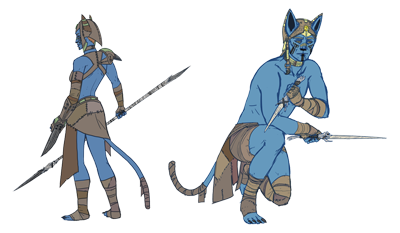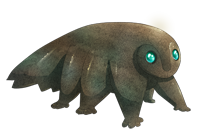 Antarctican
AntarcticanThose living on the southern continent Aphelion refer to themselves by the name of the galactic winds that directed them to this tropical-looking land of snow. Antarcticans are isolationist in nature, and have a strong bond between bands. Their relationships with those from the mainland, however, is weak at best and pathetic at the middle, they really dislike having to deal with other taothomet if they don't have to.EtymologyDictionLifespanHeightPopulationμLanguageElementsGalleryGalactic Ice
ant'ark-tih-can / soo-ankh
240 - 280 years
160 - 183 cm / 5'3" - 6'Roughly the same head height
1,450,000
Su-ankh


█
Biology
Surviving the tundra is mostly due to the haemocyanin in their blood, giving it a blue-purple colour and making their skin blue tones. Besides blue skin, they sport simple tails, claws, and their melanin pigmented inner ears and palms to trap heat. That pigmentation from the ears and nose often form patterns on the face as lines and shapes. Their hair colours are metallic shades, naturally heavy in metals.
Renaissance
They are proficient hunters and swimmers though burn through a lot of energy, resulting in the need to sleep longer than any other taothomet. The time of day for this doesn't matter for them as they are cathemeral, and will often be seen passed out wherever they became tired.
Renaissance
Renaissance forms are very Shenuankh in morph, a large cat with a twist of frozen gargoyle in looks. Spines following down the back, a spaded tail, and around the neck a set of membrane-styled wings often used for wind-related hijinks.
History
The first descendents of the Shenuankh when they entered Quiescent Mind. After being essentially removed from existence, nothing more than a stain of blood, they managed to congeal back as vaguely ankh-like creatures, called Su-ankh after them. And then were borderline cursed to wander across the continent, following where the wind took them, which seemed a bad idea when they couldn't tell where it wanted them to go in the first damn place.
The Su-ankh lineage that became the Antarcticans had survived almost entirely without change since their first fracture at Quiescent Mind. Those they left behind along the way can't say the same, a journey of fracturing, manipulation, and sometimes just plain old evolution. In the Ileli area the heka-laced pathogens exuded by the Allmother eventually created the Naha Jalin. She would go on to impact the evolutionary line of the Nechihan, her pathogens unwillingly melding the Reukh and Su-ankh during one of the major flare events from Kin.
Other Su-ankh were lost to the Awakened Forest during the flare, and after what could only be described as a time-melding experience, they emerged as Tanarika. The Su-ankh were now gone from the northwest. After leaving Ileli's borders they travelled southeast through lands now overtaken by the ocean, and their numbers once more diminished when they were grasped by the grasslands that followed. Many seemed contented by these lands and stayed, once more changed by their surroundings, swiftly transformed into Fennreng by the lands and a sprinkling of unaffected evolution.
The last remaining travellers that went south were greeted by ice floes, a pathway over the ocean and into the southern continent, a tundra paradise where the cold welcomed them, later naming their tribe after the true name of the winds. Those from the mainland often call them Aphelions, which they don't usually mind.
Culture & Society
Antarcticans live in bands created as hunting parties, and settled in areas with dense food populations. They would occasionally meet and trade goods, on the basis of keeping each other alive; if one band had plenty of food and another didn't they would not hesitate to share, as keeping their ilk healthy and alive was far more important than anything else. Today the bands aren't as closely knit as they once were, as food supplies are more guarded, but the bonds they upheld are still intact. Each band is run by a group of its oldest members, usually 3 or 5, replaced by a younger person when they feel they're too old—and for the more stubborn, when they die.
Clothing comprised of large, ill-defined saddle stitching isn't an indication of their inabilities to render hide and textiles into wearable garments. It became a style choice of their culture as a homage to their ancestors, who mostly made clothing quickly while travelling. Hides are used to protect mostly the forearms and head from weapons, fangs, and claws; anything else is just modesty. Their headdresses normally cover all of their hair and represent the wind's direction over them by depicting totems.
Socialising most often occurs around bonfires which are normally needed only for two things: cooking meals, and warding off the animals and plants that wish to pester them while socialising. If they don't pass out at the bonfire outright, they will curl up inside their in-ground housing. These wooden homes are normally one large room, sometimes sectioned off, raised enough for short windows to allow natural light. Decorations are made up of creations from pastimes such as rock and gem carvings, bead-crafting, and rug-making.
Weapons they create are made mostly from verdigris, such as daggers and javelins from the feniath trunks and branches, and arrow shafts and arrowheads from ralera scales, with flights made of starspot. When they bother they're amazing metalworkers but usually stick to creating daggers and spearheads. Certain creatures, however, can destroy or control mineral-based objects and pure plant weapons become an effective replacement.
Mythology & Folklore
Much of their mythos are made up by anything around them, regarding everything as having a meaning and totem. These totems are tied to their calendar, where each day and month hold their own meaning, and play a large role in how one is to be treated within the tribe. Names and status factor into these, as they have become a superstitious people, and will apply these symbolisms into how they raise their children and go about their daily lives.
Bhelpowe An aery made of its namesake.
Totems
Totem
Mountain
Lake
Umeon
Town
Hill
Basket
Tree
Eye
Ice
Arrowhead
Sky
Aeon
Star
Heart
Glyph
Attribute
Power
Luck
Fertility
Health
Vitality
Prosperity
Knowledge
Wisdom
Strength
Wealth
Skill
Agility
Protection
Courage
Weekday
Dylennadra
Dylennadra
Umeon
Umeon
Ioxetus
Ioxetus
Ull
Ull
Llosyllos
Llosyllos
Xem
Xem
Rin
Rin
Time
day
night
day
night
day
night
day
night
day
night
day
night
day
night
Language
Su-ankh is a mess of collected dialects and accents as they travelled around the world. They struggle to speak other languages properly, but that isn't a surprise because they also struggle with their own language. This had led to Antarcticans adopting exaggerated body language along the way as well, namely angry mannerisms and a lot of rude hand gestures.
Linguistics
ConsonantsB K G D F L M N P Q T V W Y c z h r s x
[no common words start with the miniscule letters]
Vowel SoundsA aw, ah, auh
E ay, eh, e
I ee
O uh, oh
U you, yoh
Grammarr Joining words (when second starts with vowel, or ignore if first ends in Q, R)
-in From & of / of the
i, n Plural i (after consonant), n (after vowel)
e Possessive



































